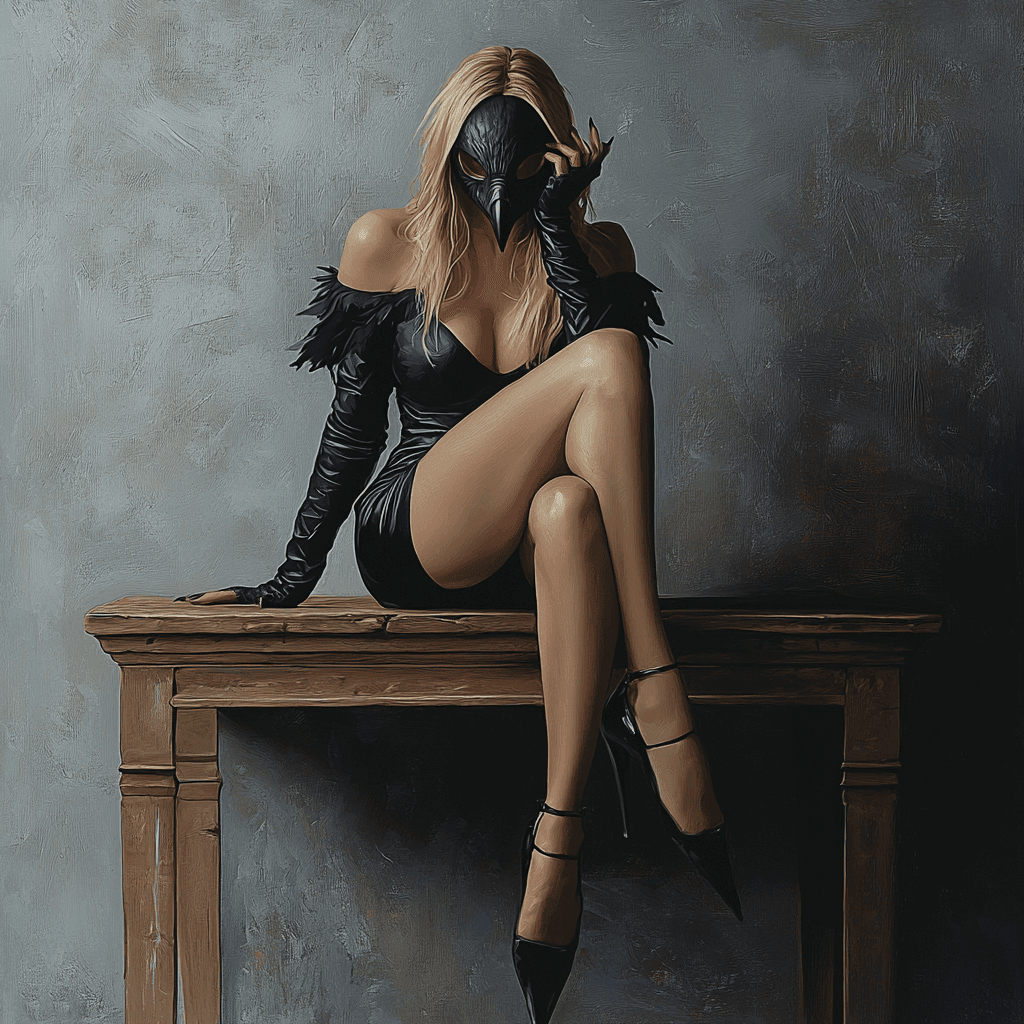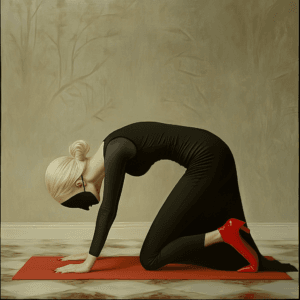Description
Exhibition Introduction and Art Critique
In the disquieting tableau of “Ante Mortem-AZ7,” AZAD 777781 once again leads us through a surrealistic journey where reality and the subconscious collide. The piece belongs to the “Ante Mortem” collection, a series that delves into the profound themes of mortality, identity, and the human psyche. Measuring 100 cm by 100 cm, this mixed media work on canvas captures the viewer with its enigmatic narrative and striking visual contrasts.
At first glance, the scene is one of juxtaposition and tension. A woman, dressed in a sleek, black dress, sits on the floor with her legs elegantly folded, her body language a mixture of calm and contemplation. Her face is obscured by a sleek, black mask resembling an anteater, a choice that immediately injects the image with an air of mystery and surrealism. Beside her, on a transparent glass table, sits a rotund creature—its ambiguous form somewhere between a rodent and a mythical beast. The creature’s solemn expression and the woman’s relaxed posture suggest an intimate, almost ritualistic encounter between two beings from different realms.
The woman’s discarded shoe lies near her, hinting at a moment of transition—perhaps from one state of consciousness to another. The polished surface of the floor and the misty, ethereal background enhance the dreamlike quality of the scene, making the viewer question the boundaries between reality and fantasy.
AZAD’s mastery of mixed media is evident in the way he renders textures and forms, creating a hyperrealistic yet surreal environment. The use of digital manipulation combined with traditional artistic techniques results in a piece that is both visually arresting and deeply symbolic. The mask, a recurring motif in AZAD’s work, serves as a powerful metaphor for the personas we adopt and the hidden aspects of our identity. The presence of the creature, however, challenges the viewer to consider what lies beyond the mask—what primal, instinctual forces remain unexpressed.
Drawing on the surrealist tradition, AZAD’s work can be compared to the masters of the 20th century, such as René Magritte and Max Ernst. Like Magritte, AZAD plays with familiar objects and settings, transforming them into something uncanny and thought-provoking. The glass table, a symbol of modernity and transparency, becomes a platform for the surreal, a meeting point between the conscious and unconscious. The creature, with its ambiguous form, echoes the fantastical beasts of Ernst’s collages, serving as a manifestation of the mind’s darker, hidden corners.
However, AZAD’s work is not merely a homage to surrealism but a contemporary reimagining of its principles. While the surrealists of the early 20th century sought to escape the rationalism they blamed for the horrors of war, AZAD’s work addresses the anxieties of the modern world—our fears of losing identity, of being consumed by technology, and of the blurring line between reality and illusion.
The technique employed in “Ante Mortem-AZ7” is a testament to AZAD’s innovative approach to digital art. By seamlessly blending photography, digital painting, and traditional artistic methods, he creates a piece that is both timeless and avant-garde. The meticulous attention to detail, from the texture of the woman’s dress to the reflective surface of the floor, demonstrates AZAD’s commitment to technical excellence. Yet, it is the emotional and psychological depth of the work that truly sets it apart, making it a profound exploration of the human condition.
—
Artistic Critique of AZAD 777781
AZAD 777781 stands as a leading figure in contemporary digital art, his work celebrated for its exploration of the complexities of the human psyche. Internationally exhibited, AZAD’s art transcends cultural and geographical boundaries, resonating with audiences through its universal themes of fear, obsession, and the subconscious.
In “Ante Mortem-AZ7,” AZAD continues his exploration of these themes, using strong figurative expressionism to mirror the emotions and struggles that define our existence. The mask, a central element in this piece, symbolizes the facades we present to the world, concealing our true selves. The creature, enigmatic and otherworldly, represents the fears and desires that lurk beneath the surface, often suppressed but never entirely silenced.
AZAD’s work is not only a reflection of the human condition but also an invitation to creativity and innovation. By pushing the boundaries of digital art, AZAD challenges us to see the world in new ways, to explore possibilities beyond our current reality. His work is a call to embrace the unknown, to confront our deepest fears and to find beauty in the surreal.
“Ante Mortem-AZ7” is a masterpiece of surrealism, embodying the movement’s core principles while also offering a fresh perspective. It is a work that defies reason, yet in its irrationality, it finds a new form of truth—one that speaks to the complexities of the human experience. Like the surrealists before him, AZAD sees the unconscious as a wellspring of creativity, a source of inspiration that can lead to profound insights about ourselves and the world around us.
In conclusion, AZAD 777781’s “Ante Mortem-AZ7” is a powerful testament to the enduring relevance of surrealism in the contemporary art world. It is a piece that not only pays tribute to the past but also pushes the boundaries of what art can be. Through his innovative use of digital media, AZAD creates a work that is both visually stunning and intellectually challenging, inviting viewers to embark on a journey into the depths of their own subconscious. This piece, like the best art, offers no easy answers but instead opens up a space for reflection and discovery, making it a truly unique and valuable contribution to the world of art.





